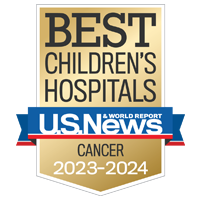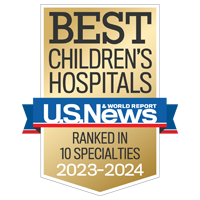Smell the roses
Wander outside into our Butterfly Garden in Oakland and our healing gardens at Mission Bay.


Germ cell tumors develop from cells that normally produce eggs or sperm in the reproductive organs — the testicles in men and ovaries in women. Germ, meaning "seed," refers to the role that germ cells play in producing egg and sperm cells. When abnormal growth and development occurs, these cells may produce a germ cell tumor. These relatively rare tumors can be cancerous or benign.
When the tumors occur in the ovary or testes, known as the gonad glands, they are called gonadal germ cell tumors. Most ovarian and testicular tumors in children originate from germ cells.
When germ cell tumors occur outside the reproductive organs, they are called extragonadal germ cell tumors. These usually occur because misplaced cells fail to migrate to their proper location in the body. Many researchers believe that extragonadal germ cell tumors are related to developmental problems that occur before birth.
Ninety percent of all germ cell tumors are gonadal. Most of the remaining 10 percent tend to occur in the chest, lower back and head.
Germ cell tumors represent about 3 percent of all childhood cancers. Researchers have not identified any toxic or environmental factors that increase the risk of this cancer. Among children, cure rates are generally good — above 90 percent — except for a few of the germ cell tumors.
To request an appointment, give us a call.
The specific characteristics of each tumor will have a major impact on the treatment prescribed and the prognosis. There are several types of both benign and malignant germ cell tumors, including the following:
These cells are malignant and usually are mixed with germ cell tumors. Among older boys, they may be the only tissue type found in testicular germ cell tumors. They may produce proteins called alpha-fetoprotein or beta chorionic gonadotropin. These tumors often resemble tissues of very early embryos and may be malignant and aggressive, meaning they grow rapidly and spread.
Endodermal sinus or yolk sac tumors are found in gonadal and extragonadal sites. They almost always produce a protein called alpha-fetoprotein. Among children, this is the most common type of malignant germ cell tumor, frequently occurring in the ovary, testes and sacrococcygeal areas in the tailbone or area near the distal end of the spinal column. Yolk sac tumors that occur outside of the ovary or testes and require surgery and chemotherapy — regardless of stage or presence of metastasis — because of the aggressive nature and recurrence of the disease. Sometimes endodermal sinus tumors in the ovary or testes can be completely removed. In these instances, chemotherapy is unnecessary, unless the tumor recurs.
Germinomas are malignant germ cell tumors. Germinomas are called dysgerminoma when located in the ovaries, and seminoma when located in the testes. Among children, germinomas occur most frequently in the ovaries of pre-pubescent or adolescent females.
Teratomas originate from cells that are capable of forming all kinds of tissues. These benign tumors may have rudimentary hair, teeth, intestine, skin or other tissues scattered within the tumor mass. Teratomas may occur at the usual germ cell sites, including the ovaries and testicles, as well as in unusual sites such as the neck, stomach and area surrounding the kidneys. Tumors in the neck may be particularly challenging in the newborn period because they may distort or obstruct the baby's airway. If completely removed, often no further therapy is needed to treat these tumors, other than repeated follow-up visits.
Symptoms for germ cell tumors vary widely, depending on the type of tumor and its location. The tumors below and their symptoms are listed by their location in the body.
Gonadal tumors are located in the reproductive organs — the ovaries in girls and the testicles in boys.
Extragonadal tumors are located outside of the reproductive organs.
Your child's doctor will perform a thorough physical examination with special attention to the area that corresponds to your child's symptoms. Alfa-feto protein and human chorionic gonadotropin studies will be performed on your child's blood in addition to other blood studies. Various imaging studies, depending on the tumor's location, will also be required. These include:
Sometimes a diagnostic biopsy is needed before surgery is performed to remove the entire tumor.
Treatment depends on the location and type of the tumor and the extent of the disease. For some tumors, complete surgical removal is possible and effective, with close follow-up after surgery. Some germ cell tumors may be treated with radiation therapy alone or in combination with surgery. Chemotherapy is very effective for malignant germ cell tumors and is almost always used in combination with surgery.
With the exception of relatively few germ cell tumors in children, cure rates are 90 percent or higher.
UCSF Benioff Children's Hospitals medical specialists have reviewed this information. It is for educational purposes only and is not intended to replace the advice of your child's doctor or other health care provider. We encourage you to discuss any questions or concerns you may have with your child's provider.

Best in Northern California for cancer care

Ranked among the nation's best in 10 specialties
Smell the roses
